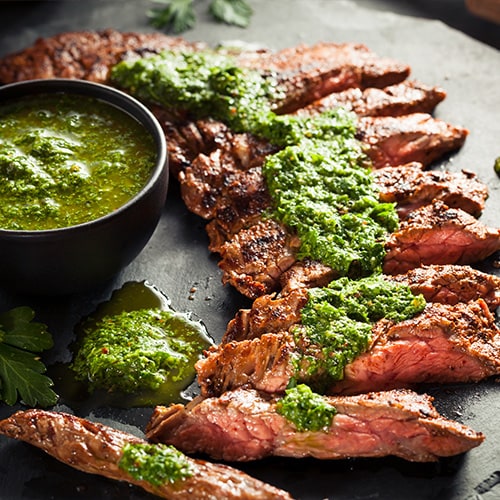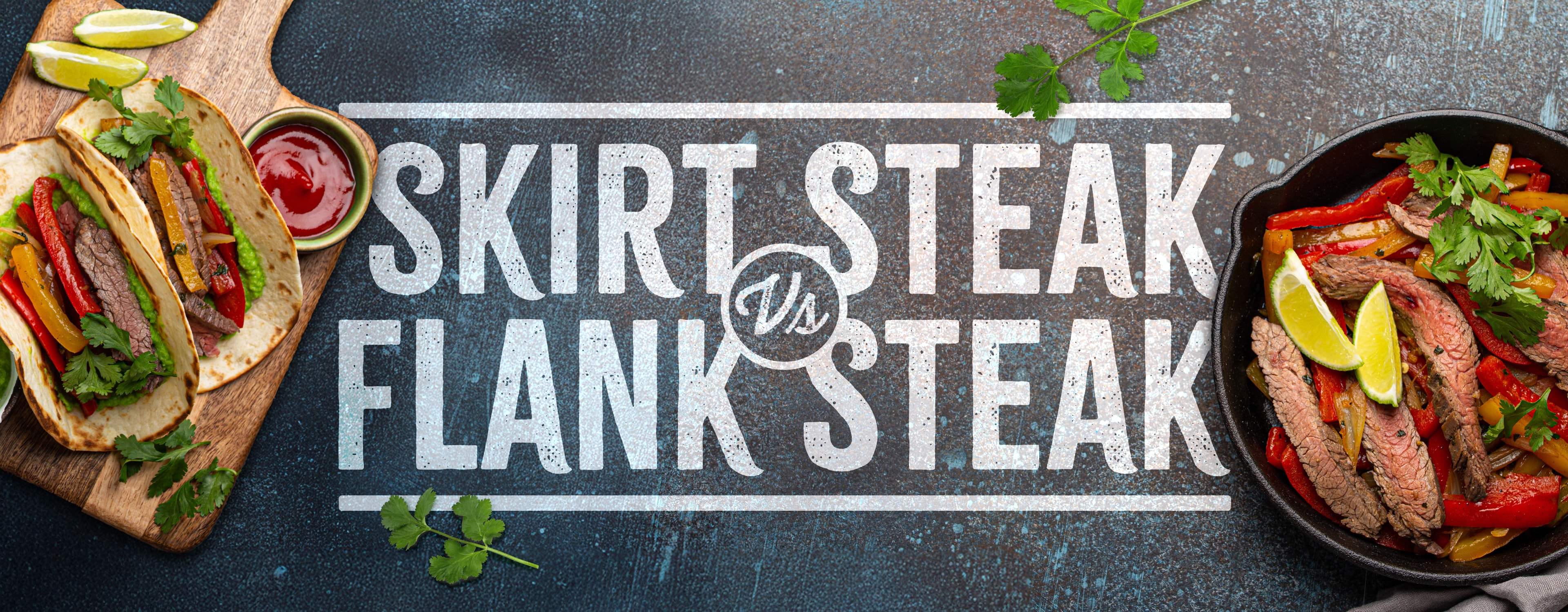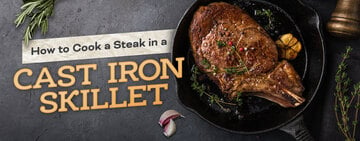What Is the Difference Between Skirt Steak and Flank Steak?
Last updated on Mar 10, 2025Kayla NelsonSkirt and flank steak are two different types of steak that often get mixed up because they are both affordable cuts of beef that benefit from marinating and high-heat cooking. However, the two have a few telltale differences, most notably their shape and how their muscle fibers run. Skirt steak is a longer, thinner, and more narrow cut with muscle fibers that run across the width of the steak. In comparison, flank steak is a shorter, thicker, and wider cut with muscle fibers that run down its length. Keep reading to learn more about these lean cuts of steak, where they’re found on the cow, and how to use them in your dishes.

Shown here: Uncooked skirt steak compared to uncooked flank steak. The skirt steak's grain runs across its width, and the flank steak's grain runs across its length.
What Is Skirt Steak?

Skirt steak is a flavorful and relatively thin cut of beef known for its intense beefy flavor and affordability. The name "skirt steak" is derived from the fact that the muscle fibers run across the width of the meat, giving it a pattern resembling the pleats of a skirt. It is also commonly referred to as "fajita steak" since it is the traditional cut for fajitas.
Skirt steak is divided into two distinct cuts: inside and outside, each originating from different muscles within the chest and abdomen. The inside skirt comes from the transversus abdominis muscle, making it thinner, tougher, and with more connective tissue fibers. It’s the more common cut found in grocery stores, often labeled simply as "skirt steak." The outside skirt, sourced from the diaphragm muscle, is the more prized cut, especially in restaurants, due to its greater thickness, consistent shape, and superior marbling, which results in a more tender and flavorful steak.
What Does Skirt Steak Taste Like?
Skirt steak boasts a rich, beefy flavor with a generous amount of marbling, thanks to its higher fat content. Its coarse grain benefits from marinating to help break down the muscle fibers, enhancing both tenderness and flavor, while slicing against the grain will further minimize the chew associated with tougher cuts.

Where Is Skirt Skirt Steak on a Cow?
Skirt steak is sourced from the plate primal, situated just below the rib primal on the cow, and runs parallel to the cow's diaphragm. Each cow yields four skirt steaks - two inside skirt steaks and two outside skirt steaks.
How to Cook Skirt Steak
Skirt steak is best cooked quickly over high heat, which helps to keep it juicy while also developing a nice char on the outside. Grilling, searing, and broiling are all great cooking methods. For best results, cook the steak to no more than medium rare doneness to keep it from getting too tough.
What Is Skirt Steak Used For?
Skirt steak is commonly used for fajitas, tacos, and stir-fries due to its bold flavor and tenderness when marinated. It’s also great for skewers, topping salads, or simply served as a sliced steak with sauce and a hearty side.
What Is Flank Steak?

Flank steak, also known as jiffy steak, is a beef cut from the cow’s abdominal muscles. It's a lean and long, flat cut with a distinct, tight grain that runs along the length of the steak. The grain is generally straight and even, which makes slicing against the grain easy after it’s cooked, a crucial step for ensuring tenderness. The muscle fibers are relatively coarse, contributing to the steak's characteristic toughness, but break down with the help of an acidic marinade to give it a melt-in-your-mouth quality.
What Does Flank Steak Taste Like?
Despite its somewhat tougher texture compared to more tender cuts like ribeye or tenderloin, flank steak is prized for its robust beefy flavor that stands up to marinades, spices, and seasonings. The lack of marbling means that the flavor comes primarily from the meat itself, and its leanness makes it a great option for those seeking a flavorful yet low-fat cut of beef.

Where Is Flank Steak on a Cow?
Flank steak comes from the flank primal, located beneath the loin and in front of the hindquarters, and is the only beef cut the primal produces. This area consists of muscles for movement and support, meaning the fibers are relatively long and coarse. There are two flank steaks per whole cow.
How to Cook Flank Steak
Flank steak is an incredibly versatile cut of beef that can be cooked several different ways. Like skirt steak, flank steak is an excellent choice for marinating and cooking over high heat, such as grilling, searing, or broiling, where it can quickly develop a rich, caramelized crust while retaining its juicy interior. For those seeking a different approach, you can also try low-and-slow cooking methods like braising, smoking, and sous vide. No matter how it's cooked, slicing it thinly against the grain is key to maximizing its tenderness. Flank steak should also not be cooked beyond medium rare, as cooking it longer can make it too tough.
What Is Flank Steak Used For?
Flank steak's versatility extends beyond just its cooking methods; it’s equally flexible in the number of dishes it can be used in. This cut is a popular choice for carne asada, stir-fries, and steak sandwiches, and it makes a delicious protein option for salads and grain bowls. Its thickness and ability to absorb marinades make it the go-to cut for a tender and flavorful London broil.
Skirt Steak vs Flank Steak
Skirt steak and flank steak are both flavorful cuts of beef from the lower chest area of the cow, but they have some key differences in their tenderness, flavor, grain, and shape.
- Tenderness: While both are tougher cuts that benefit from marinating, skirt steak’s higher fat content makes it slightly more tender than flank steak.
- Flavor: Skirt steak is more intense due to its marbling and higher fat content. Flank steak is leaner and a bit less rich in flavor.
- Grain: Not only are the grain directions different, but skirt steak's grain is looser than that of flank steak, which allows marinades to permeate more easily. Flank steak has a denser, tighter grain and therefore needs more time to marinate.
- Shape: Skirt steak is a longer, thinner, and narrower cut. Flank steak is broader, slightly shorter in length, and nearly twice as thick as skirt steak.
Can Skirt Steak and Flank Steak Be Used Interchangeably?

Yes, their beefy flavor and similar texture make skirt steak and flank steak great substitutes for one another in recipes. While they both absorb marinades well and are ideal for high-heat cooking, their thickness and grain direction differentiate how they should be prepared.
- Marinade Time: Skirt steak is generally more tender and marbled, so it benefits from a shorter marinade time, around 30 minutes to 2 hours. Flank steak, on the other hand, is leaner and a bit tougher, so it benefits from a longer marinade, typically 4 to 8 hours, or even overnight, to help break down the muscle fibers.
- Cook Time: Skirt steak cooks relatively quickly due to its thinner cut, often just 3 to 5 minutes per side on high heat for a nice sear. Flank steak is slightly thicker and should be cooked for 4 to 6 minutes per side, depending on thickness, to achieve medium-rare doneness. Overcooking either cut will make it tough, so quick, high-heat cooking is key.
- Cutting Against the Grain: Since the grain on skirt steak and flank steak run in opposite directions, you will also need to slice them differently, too. Skirt steak should be sliced lengthwise against the grain, while flank steak should be sliced crosswise against the grain.
Flank steak and skirt steak offer a rich, beefy flavor that makes them standout cuts for a variety of dishes. Proper tenderizing can enhance their already savory profiles, making them ideal for everything from fajitas and tacos to stir-fries. Their affordability adds to their appeal, providing a cost-effective option without sacrificing taste or quality. Whether you're looking to elevate a simple meal or create something a bit more adventurous, both flank and skirt steaks are excellent choices that can fit seamlessly into any menu.








